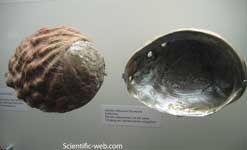|
The red abalone, Haliotis rufescens, is a species of very large edible sea snail, a marine gastropod mollusk in the family Haliotidae, the abalones, ormer shells or paua. Red abalone is the largest,[1] and most common abalone found in the northern part of the state of California, and it is the only species of abalone stil legally harvested (on a restricted basis) there. The red abalone can be found along the west coast of North America, from Oregon to Baja California, and Mexico. Habitat Red abalone live in rocky areas with kelp. They primarily feed on bull kelp and giant kelp. They are found from the intertidal zone to water of 100 foot depth. Shell description The red abalone's shell length can reach a maximum of 31 cm, making it the largest species of abalone in the world. The shell is large, thick, and dome-shaped shell. It is usually a brick red color externally. Typically the shell has three or four oval respiratory pores. The inside of the shell is strongly iridescent and has a large central muscle scar. External anatomy of the soft parts Below the shell the black epipodium and tentacles can be seen. The underside of the foot is a yellowish white in color. Life habits This sea snail feeds on kelp and other algae. Diseases Red abalones are subject to a chronic, progressive and lethal disease: the Withering Syndrome or abalone wasting disease. This disease has had a poorly understood impact on the species overall, but populations still seem low. Human use Red abalone has been exploited since prehistoric times--red abalone shells have been found in Channel Island archaeological sites dated to nearly 12,000 years old. Red abalone middens--refuse deposits where red abalone shells are a major constituent--are abundant in archaeological sites of the Northern Channel Islands dated between about 7500 an 3500 years ago. The Native American Chumash peoples also harvested this species along the Central California coast in the pre-contact era.[2]. The Chumash and other California Indians also used red abalone shells to make a variety of fishhooks, beads, ornaments, and other artifacts. Farming Because of the destruction of most wild populations of abalone, abalone farming has become a booming business. The red abalone is the most popular species farmed. Unlike some aquaculture, growing abalone has little environmental impact because they eat fast growing kelp, which regrows quickly upon harvest. Wild harvest Through most of its range the red abalone populations were decimated by commercial fishing. As a result this is currently illegal throughout its range, leaving wild red abalone a popular target of poachers. In Northern California however commercial fishing was only legal for three years during World War Two. As a result a recreational fishery still exists in northern California. Because SCUBA is banned, the fishery consists of shore pickers searching the rocks at low tide, and free divers using breath-hold diving to search for them. This essentially creates a reserve for the abalone in the water below thirty feet where few divers are skilled enough to go. Currently the minimum legal size is 7 inches, and three specimens may be taken on any given day. There is also a yearly legal limit of 24 abalone per person. References 1. ^ Red Abalone [1] External links
Retrieved from "http://en.wikipedia.org/" |
|

